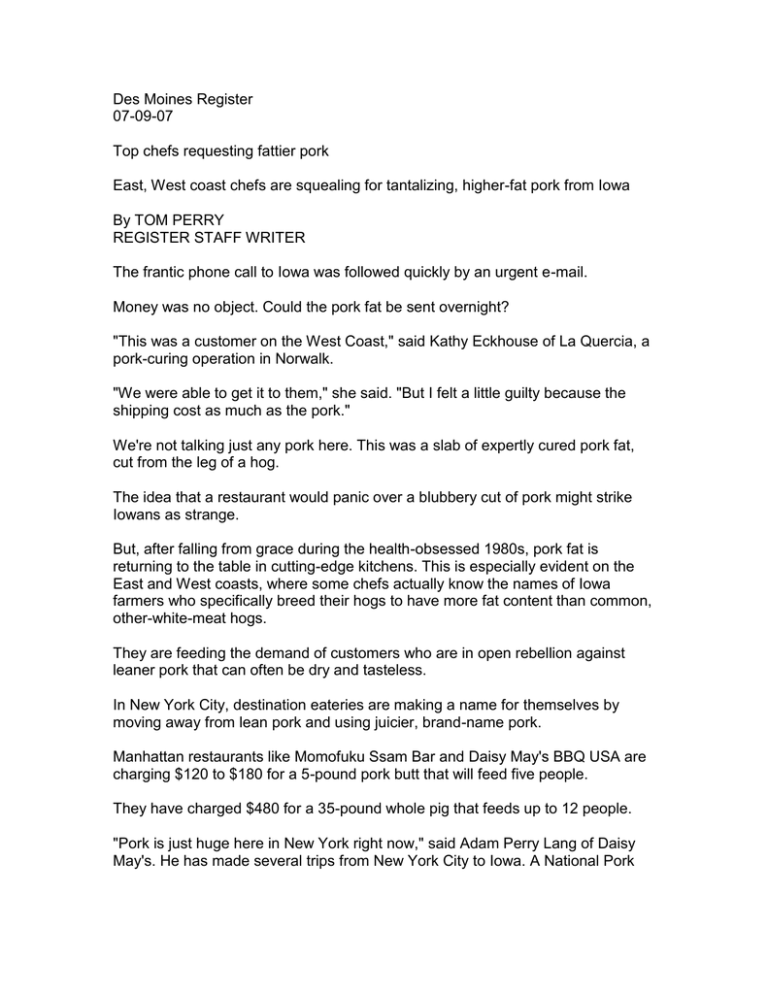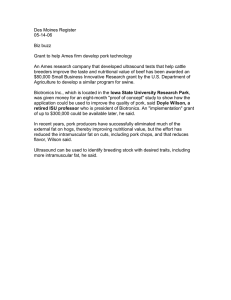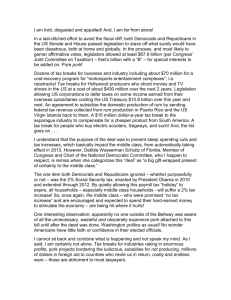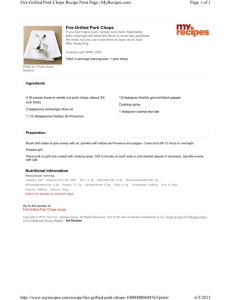Des Moines Register 07-09-07 Top chefs requesting fattier pork
advertisement

Des Moines Register 07-09-07 Top chefs requesting fattier pork East, West coast chefs are squealing for tantalizing, higher-fat pork from Iowa By TOM PERRY REGISTER STAFF WRITER The frantic phone call to Iowa was followed quickly by an urgent e-mail. Money was no object. Could the pork fat be sent overnight? "This was a customer on the West Coast," said Kathy Eckhouse of La Quercia, a pork-curing operation in Norwalk. "We were able to get it to them," she said. "But I felt a little guilty because the shipping cost as much as the pork." We're not talking just any pork here. This was a slab of expertly cured pork fat, cut from the leg of a hog. The idea that a restaurant would panic over a blubbery cut of pork might strike Iowans as strange. But, after falling from grace during the health-obsessed 1980s, pork fat is returning to the table in cutting-edge kitchens. This is especially evident on the East and West coasts, where some chefs actually know the names of Iowa farmers who specifically breed their hogs to have more fat content than common, other-white-meat hogs. They are feeding the demand of customers who are in open rebellion against leaner pork that can often be dry and tasteless. In New York City, destination eateries are making a name for themselves by moving away from lean pork and using juicier, brand-name pork. Manhattan restaurants like Momofuku Ssam Bar and Daisy May's BBQ USA are charging $120 to $180 for a 5-pound pork butt that will feed five people. They have charged $480 for a 35-pound whole pig that feeds up to 12 people. "Pork is just huge here in New York right now," said Adam Perry Lang of Daisy May's. He has made several trips from New York City to Iowa. A National Pork Board Celebrated Chef from New York, Lang is a former champion of the Great Pork BarbeQlossal at the World Pork Expo, held in Des Moines. "Chefs are in love with the fat because it carries so much flavor and because special niche pork makes it easier for chefs to do very special things.'' La Quercia's cured pork fat, for example, is a versatile flavor enhancer in the hands of a creative chef. Cut from specially bred Iowa hogs, the pork fat can add sweet succulence to a saute or simply be mixed with herbs and allowed to melt slowly over warm bread, said Herb Eckhouse of La Quercia. A New York Times food critic wrote last month that these are "porky times, fatty times, which is to say very good times indeed. "Any new logo for the city could justifiably place the Big Apple in the mouth of a spit-roasted pig. ..." On the West Coast, consumers are paying premium prices for fattier pork that also happens to be raised humanely, Le Mars-based producer Tim Beeler said. Dozens of markets and restaurants carry Beeler's brand of pork. All of the pigs are specially bred to have more intramuscular fat content than mass-market, confinement hogs, he said. Interestingly, many of the fatter pork hogs are likely to be fed leaner rations than other hogs, he added. The all-natural diets of most niche pork hogs would not include animal byproducts, which can have higher fat content than grains. A fifth-generation farmer, Beeler is among the estimated 35 to 40 niche pork producers in Iowa, according to the National Pork Board. Some of the meat is referred to as "heritage pork," a throwback to the pork produced during the days well before the 1987 introduction of "the other white meat." Whatever it's called, niche pork can be pricey. Beeler said his pork products sell for 20 percent to 30 percent more than conventional pork. Yet sales are brisk. "Today, we can't raise enough pigs," Beeler said. The interest in fattier pork should surprise no one, especially after mass producers succeeded in breeding leaner hogs, said Joanna Preus, the New York City-based author of "Seduced by Bacon: Recipes & Lore about America's Favorite Indulgence." "People want flavor, and fat is flavor," she said. "We've been so brainwashed that fat is bad, as a consequence we are now discovering that food with a little fat actually had a little flavor." Consumers are also discovering brand names. Niman Ranch and Berkshire - a breed of hog that has its own cachet - have become the designer brands of the pork industry. Chefs and connoisseurs seek out these niche products much the way fashion slaves seek out brands like Chanel, Valentino or Louis Vuitton. Whether the increased demand for fattier pork elsewhere will grease the skids for fattier pork in Iowa restaurants and markets is difficult to predict, local chefs say. Currently, it might be easier to buy a fatty niche pork product, such as a pork belly, at a restaurant in New York or California than in the state with the most hogs in the country. "It can be hard to introduce new concepts here," said Rob Beasley, chef at Mojo's on 86th in Johnston. "The market is a lot more traditional in this part of the Midwest, and people are a little more reluctant to try something if they're not familiar with it." It hardly matters that fattier "heritage" pork is actually more traditional than the leaner, mass-market pork that's readily available today, Beasley said. "With so few independent restaurants in this area, you're probably not going to see a lot of restaurants focusing on items with more pork fat," he said. As it is, one particular pork product known for coming from a fatty cut has become increasingly available in the Des Moines area with the proliferation of barbecue joints in the past few years. Last Thursday's opening of Absolute Flavors-Smokey D's BBQ, 20 N.W. 54th Ave., brought to 21 the number of eateries in the area featuring either sit-down or take-away barbecue. Co-owner Shad Kirton, formerly the chef at Hotel Pattee in Perry, said the pulled pork sold at most barbecue restaurants uses meat that comes from an especially fatty cut - the butt or shoulder. "Most everybody is using pork from a Boston butt or shoulder, and that's what you definitely want," Kirton said. "Even if the pig is leaner, if you smoke it right, you're going to get that great moist flavor." Pork business is booming in Iowa When it comes to pork production, the nation turns to Iowa. There were 17.8 million hogs and pigs on farms in the state as of June 1 - the most in the nation - according to the U.S. Department of Agriculture's quarterly report. The number of hogs in the state is up 7 percent over a year ago. Farrow-to-finish hog producers in Iowa have had a profitable 10 years, Iowa State University Extension statistics showed last fall, with average returns for the last 10 years of $2.50 for each hog sold. North Carolina ranks second in the nation with 9.2 million hogs and pigs. There were 62.7 million hogs on U.S. farms as of June 1, the USDA report said. That's a 2 percent increase from a year ago. Reporter Tom Perry can be reached at (515) 284-8224 or tperry@dmreg.com


